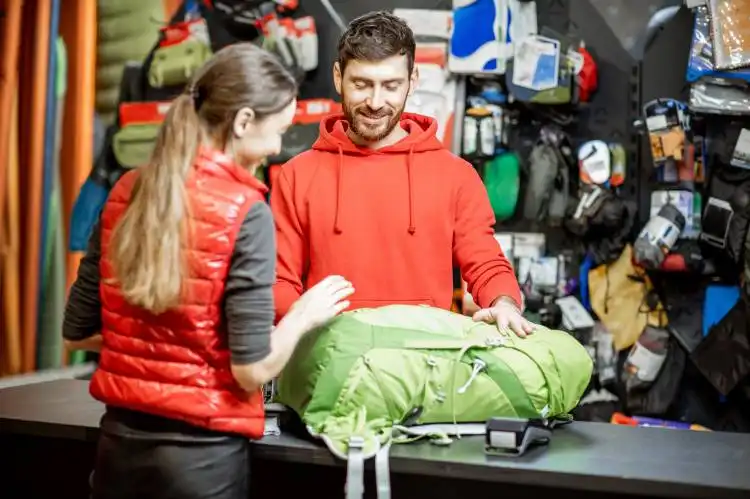Start an Exercise Clothing Store
Revolutionizing Fitness Fashion: Your Journey as a Trendsetter in Athletic Wear
| Updated


EXERCISE CLOTHING STORE
Welcome to the world of fitness and fashion fusion with your own Exercise Clothing Store! This trendy business offers both workout enthusiasts and fashion gurus a place to find stylish and high-performing workout wear. Not just a retailer, you'll be the stylist of sweat therapy, the tailor for toning, and the outfitters of oxytocin-overflows, showcasing an array of garments such as leggings, sports bras, tank tops, and athletic shoes designed to make people look good while getting fit. Fitness never looked so fabulous!
Jump to Business Plan
RELATED BUSINESS IDEAS
Browse ALL Clothing & Fashion Trends Business Ideas
Discover Your Perfect Domain
Unlock the door to your online success with our hand-picked selection of premium domain names. Whether you're starting a new venture or rebranding an existing one, the right domain can set the tone for your digital presence. Browse through our curated list, each with its unique potential to enhance your brand's visibility and credibility.
EXERCISE CLOTHING STORE MINI BUSINESS PLAN
This a quick reality check to help you identify the strengths and weaknesses of your business concept before you dive in.
Expected Percent Margin:
- Gross Margin: 45-55%
- Net Profit Margin: 5-15%
Earnings Expectations:
- Daily Earnings: $150 - $400
- Weekly Earnings: $1,050 - $2,800
- Monthly Earnings: $4,500 - $12,000
- Annual Earnings: $54,000 - $144,000
Actions to Achieve These Numbers:
Registration and Setup:
- Business Registration: Register your business and the associated licenses.
- Location: Choose a location that is easily accessible and has a high demand for exercise apparels.
Inventory Management:
- Initial Investment: Around $15,000-$35,000 for trendy, high-quality inventory.
- Supplier Network: Build relationships with reliable clothing manufacturers.
Marketing and Customer Acquisition:
- Digital Marketing: Allocate 5-10% of gross profits towards digital marketing - social media, email newsletters, SEO etc.
- Local Marketing: Host engaging community events like fun runs, yoga classes, etc.
Sales and Customer Experience:
- Staffing: Hire 1-2 full-time employees with good knowledge of sportswear and fitness.
- Customer Service: Exceptional service, including personal recommendations and comfortable changing rooms.
Cost Control:
- Rent: It should be approximately 5-10% of expected monthly sales.
- Utilities and Maintenance: Estimate around $200-$400 per month.
Business Operations:
- Operating Hours: Open at least 6 days a week, ideally 8-10 hours a day.
- Transaction Volume: Aim for 10-30 transactions per day with an average sale price of $30-$80.
This outline provides a guideline and the exact figures can vary based on the region, competition, and the specific execution of the business plan. Always seek advice from a business consultant or financial advisor for exact numbers.
NOT WHAT YOU HAD IN MIND? Here are more ideas



Browse ALL Clothing & Fashion Trends Business Ideas
Grab Your Business Website Name
Before you get caught up in the whirlwind of setting up your business, invest in a domain name. It's a small but significant step that lays the foundation for your brand and makes it easier for customers to find and trust you. Just like you wouldn't build a house without securing the land first, don't build a business without securing your domain name.
"Why? Can't that wait?" Here's why it shouldn't
Step 1: Determining if the Business is Right for You
Examples of Ways to Make Money
Step 1: Determining if the Business is Right for You Before starting an exercise clothing store, it is important to determine if the business is right for you. This includes analyzing both the startup and ongoing expenses associated with the business. It is also important to consider potential ways to make money.
Analyzing Startup Expenses
When determining if the business is right for you, it is important to analyze the startup expenses. This includes the cost of renting a space, purchasing inventory, hiring employees, and any marketing costs. Additionally, you should consider the cost of any necessary licenses or permits.
Analyzing Ongoing Expenses
In addition to analyzing startup expenses, it is important to consider the ongoing expenses associated with running an exercise clothing store. This includes the cost of rent, utilities, inventory, and employee wages. Additionally, you should consider the cost of any necessary insurance, taxes, and other fees.
Examples of Ways to Make Money
When determining if the business is right for you, it is important to consider potential ways to make money. This includes selling exercise clothing, offering custom design services, and hosting events. Additionally, you could offer discounts or loyalty programs to customers. You could also consider partnering with other businesses to offer discounts or promotions.
Step 2: Naming the Business
When coming up with a name for your business, it is important to consider what the business is about and what it stands for. It should be something that is easy to remember and that conveys the message you want to send. Additionally, it should be something that is unique and stands out from other businesses in the same field.
When coming up with a name, it is important to consider how the name will look on a business card, website, or other marketing materials. It should be something that is easy to read and pronounce. Additionally, it is important to make sure that the name is not already taken or trademarked. It is also important to consider how the name will look in a search engine, as this will be one of the primary ways customers will find your business.
When coming up with a name, it is also important to consider the potential for growth. The name should be something that can grow with the business and that can be adapted to different products or services. Additionally, it is important to consider the potential for expansion into other markets.
Finally, it is important to consider the potential for branding. The name should be something that can be used to create a recognizable brand that customers can identify with. Additionally, it should be something that can be used to create a unique and memorable logo.
Step 3: Creating a Business Plan
Identifying Target Market
Before creating a business plan, it is important to identify the target market for the exercise clothing store. Who is the store going to cater to? Are they going to be selling to athletes, fitness enthusiasts, or everyday people? Knowing the target market will help determine the type of clothing the store will carry and the price range of the items. It will also help to determine the best location for the store and the marketing strategies that will be used to reach the target market.
Establishing Business Goals
Once the target market has been identified, it is important to establish the business goals. What are the short-term and long-term goals for the store? What is the desired profit margin? What is the desired customer satisfaction rate? What is the desired rate of return on investment? Knowing the answers to these questions will help to create a plan for the store that will ensure its success. Additionally, it will help to create a timeline for when the store should be profitable and when certain goals should be met.
Step 4: Choosing a Location
When choosing a location for an exercise clothing store, there are several factors to consider. First, the store should be located in an area with high foot traffic, as this will help to draw in customers. Second, the store should be close to other businesses that cater to the same demographic, such as gyms, fitness centers, and health food stores. Third, the store should be located in an area with ample parking, as this will make it easier for customers to access the store. Finally, the store should be located in an area with good public transportation access, as this will make it easier for customers to reach the store.
Securing a Location
Once the ideal location has been identified, the next step is to secure the location. This can be done by signing a lease with the landlord or property owner. It is important to read through the lease carefully and make sure that all of the terms and conditions are acceptable. Additionally, it is important to make sure that the store has all of the necessary permits and licenses to operate in the area. This may include a business license, a health permit, and a zoning permit. Once all of the necessary paperwork is in order, the store can begin to operate.
Step 5: Obtaining Licenses and Permits
Before starting an exercise clothing store, it is important to research and obtain the necessary licenses and permits. Depending on the location of the store, different licenses and permits may be required. For example, a business license, a sales tax permit, and a health permit may all be required. Additionally, depending on the type of business structure chosen, additional permits and licenses may be needed. For example, if the business is a corporation, a corporate filing may be necessary.
Where to Obtain Licenses and Permits
Once the necessary licenses and permits have been identified, the next step is to obtain them. Depending on the location of the store, the licenses and permits can be obtained from the local city or county government, or from the state government. Additionally, some of the licenses and permits may be available online, while others may need to be obtained in person. It is important to research the specific requirements for each license and permit, as well as the cost associated with obtaining them.
Cost of Licenses and Permits
The cost of obtaining the necessary licenses and permits varies depending on the type of license and permit, as well as the location of the store. Generally, the cost of obtaining a business license is relatively low, while the cost of obtaining a sales tax permit may be higher. Additionally, the cost of obtaining a health permit may vary depending on the type of store and the location of the store. It is important to research the cost of the licenses and permits before starting the business.
Time Frame for Obtaining Licenses and Permits
The time frame for obtaining the necessary licenses and permits also varies depending on the type of license and permit, as well as the location of the store. Generally, the time frame for obtaining a business license is relatively short, while the time frame for obtaining a sales tax permit may be longer. Additionally, the time frame for obtaining a health permit may vary depending on the type of store and the location of the store. It is important to research the time frame for obtaining the licenses and permits before starting the business.
Step 6: Setting Up the Store
Designing the Store Layout
When designing the store layout, it is important to consider the customer experience. Think about how customers will move through the store and how to best display the merchandise. Consider the size of the store and how to make the most of the space. Take into account the type of merchandise you will be selling and how to best display it. For example, if you are selling activewear, you may want to create a separate section for each type of clothing, such as tops, bottoms, and accessories. Additionally, consider the lighting and the overall atmosphere of the store.
Choosing Store Fixtures
Once the store layout is designed, it is time to choose the store fixtures. Store fixtures are the items used to display merchandise, such as shelves, racks, and mannequins. When choosing store fixtures, consider the type of merchandise you will be selling and the size of the store. For example, if you are selling activewear, you may want to choose fixtures that are designed to hang clothing, such as wall racks or garment racks. Additionally, consider the material of the fixtures and the overall look and feel of the store. Make sure the fixtures are of good quality and match the aesthetic of the store. Finally, consider the cost of the fixtures and how they fit into your budget.
Step 7: Buying Inventory
Once you have determined the types of clothing you want to sell, you need to find a reliable source for buying inventory. There are a few different options for sourcing inventory, including buying from wholesalers, manufacturers, or even dropshipping. Wholesalers are a great option for buying bulk inventory at discounted prices, while manufacturers can provide custom clothing with your store’s logo or design. Dropshipping is a great way to avoid the hassle of storing and shipping inventory, as you can simply have the supplier ship directly to your customers.
Negotiating Prices
Once you have identified a few potential sources for your inventory, you can start negotiating prices. It is important to remember that the more you buy, the more you can negotiate for a better price. You should also consider any additional costs associated with the purchase, such as shipping and handling fees. Additionally, you should always ask for discounts or special offers, as many suppliers are willing to offer discounts to new customers.
Stocking Inventory
Once you have purchased your inventory, you need to find a place to store it. If you have a physical store, you can store the inventory in the backroom or in a storage closet. If you are selling online, you may need to find a third-party warehouse or storage facility to store your inventory. You should also consider the cost of storing your inventory, as this can add up quickly.
Tracking Inventory
Finally, you need to track your inventory to ensure you always have enough stock to meet customer demand. You can use a simple spreadsheet to track your inventory, or you can invest in inventory management software to help you keep track of your stock levels. This will help you avoid running out of stock and ensure that you always have enough inventory to meet customer demand.
Step 8: Marketing the Store
Examples of Ways to Make Money
One way to make money with an exercise clothing store is to offer discounts and promotions for customers who purchase multiple items. This encourages customers to buy more items, which increases the store's profits. Additionally, offering loyalty programs or rewards for customers who make frequent purchases can also be a great way to make money. Furthermore, offering limited-time sales and discounts can also be an effective way to increase profits. Finally, partnering with other businesses in the same industry can be beneficial, as it can help to increase the store's customer base.
Examples of Marketing Strategies
One way to market the store is to create an online presence. This can include creating a website, setting up social media accounts, and creating an email list. Additionally, creating content such as blog posts, videos, and podcasts can be a great way to reach potential customers. Furthermore, offering discounts and promotions for customers who sign up for the store's email list can help to increase the store's customer base. Additionally, advertising in local newspapers, magazines, and radio stations can also be an effective way to reach potential customers. Finally, attending local events and trade shows can be a great way to get the word out about the store and its products.
Step 9: Opening the Store
Opening a store can be a daunting task, but with the right preparation and planning, it can be a successful endeavor. Before opening the store, it is important to make sure that all necessary permits and licenses are in place. Additionally, it is important to make sure that the store is properly stocked with the correct inventory. It is also important to make sure that the store is properly staffed and that all employees are properly trained. Finally, it is important to make sure that the store is properly marketed and that customers are aware of the store's existence.
Promotional Strategies
Once the store is open, it is important to make sure that customers are aware of the store's existence. This can be done through various promotional strategies, such as advertising in local newspapers and magazines, creating a website, and using social media. Additionally, it is important to create a loyalty program for customers, such as offering discounts or special promotions. It is also important to create a rewards program for customers who refer new customers to the store. Finally, it is important to create a presence at local events, such as trade shows, to increase visibility and attract new customers.
EXPLORE MORE CATEGORIES
Browse ALL Business Idea Categories
TAKE THE NEXT STEPS










